v12.07.14
Art, Architecture and Design
This article spotlights a particular building or some other aspect of Columbus design. I welcome your comments, corrections and additions. Please share your experience and perceptions of these uniquely Columbus projects.
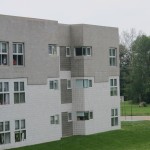 Clifty Creek Elementary School
Clifty Creek Elementary School
- Built: 1982
- Principal Design Architect: Richard Meier (Richard Meier and Partners – NYC)
- Assisant Principal Design Architect: Gerald Gurland (Richard Meier and Partners – NYC)
- Associate in Charge: Philip Babb (Richard Meier and Partners – NYC)
- Addition 1997: Stamberg Aferiat Architecture – NYC
Clifty Creek Elementary sits high atop a sloping 22 acre site of very uneven terrain overlooking US 31 at the south edge of Columbus. The building is constructed using white-glazed tile blocks as a base, grey aggregate block above, and glass. Unusual for a Meier design as he usually prefers one color: white. People are often quite shocked to see this two-toned color scheme as well as an occassional splash of color inside. The interior is nearly all white as Meier felt that the children would provide the color thru their creations as well as their mere presence. A variety of colors were used in the recessed entries to the classrooms and one wall of the interior hallway in the classroom wing. The large curved wall at the end of the building resembling the stern of a ship was painted purple on the inside. One of the reasons Meier was selected for the project was that he had never designed a school and they were hoping for some fresh ideas and not just a previous design pulled from the architects file cabinet. The angular grey and white building bears some resemblance to a large ocean-going vessel and has been described as a “ship-like school on a sea of grass.”
At the sites lower end is a 3-story classroom wing, its levels arranged hierarchically higher by grade. Each floor features 2 symmetrical suites with 4 – 900 square foot classrooms, partitioned with movable walls allowing 2 classrooms to merge. The movable walls are soundproofed as well as providing bulletin board space. Each classroom has specially designed storage spaces including a storage box (“cubbies”) for each student. A glass-walled area shared by each pair of classrooms can be used for private group sessions, study areas or an isolated space for teachers allowing them visual access to the classrooms. Each floor has a separate teacher preparation/meeting area. Classrooms connect to the common and specialty areas by a system of ramps.
The specialty and service areas are contained in a large square, with each quadrant of this square containing a different activity: library, cafeteria, gymnasium, and art/music/special rooms with each area having it’s own entry.
The double-height library is adjacent to the classroom wing and features a free-form balcony that cantilevers from one end for story telling or intimate reading. The ramp system runs along the south side of the library flanked by a glass wall with views into the outdoor courtyard. Students pass thru the library area using a series of 3 ramps to get to the various levels and special areas of the building. It was felt that the library is the center of learning in a school so it was placed in the heart of the building. Meier called the library “the core of learning” so he made it the hub of the building with all the ramps passing through hopefully inspiring students to become comfortable with the library and to stop and explore the resources.
Across from the library and the courtyard is the cafeteria: kitchen and service areas on the south side and a curved stage area at the west end for group presentations. The cafeteria’s canted, glass-paned, north wall faces the glass wall of the ramp allowing back and forth views.
The northwest quadrant contains the gymnasium and physical education facilities. The northeast quadrant contains art, music rooms and other special classrooms with a semi-circular vestibule feeding off the main north entry. Although built before ADA requirements were in place, the school was designed for easy access for physically challenged students.
At the dedication on Sunday November 7th, 1982, it was called the finest elementary school in the state of Indiana by T. Randall Tucker, a member of the Indiana Commission on General Education. The school was granted a first class commission by the State of Indiana based on the building along with the staff and planned curriculum. Architect Richard Meier attended the dedication and modestly remarked that he hoped his then very young children would be able to attend a school as fine as this one. Although it is still considered a rural school, Columbus residential neighborhoods surround the school site and major retail developments are now located just across the US 31 bridge. This school was built to replace the Petersville and Clifty Elementary Schools.
An addition/renovation in 1997 by Stamberg Aferiat Architecture (Peter Stamberg and Paul Aferiat) added 8 classrooms, a sophisticated media retrieval system, teacher prep rooms and additional restrooms. The entire structure was retrofitted to meet current ADA requirements. The addition was “seamless” and respectful to match the original Richard Meier design concept. The primary axis of the school was extended in both directions. 6 of the classrooms are staged to the west of the original classroom wing with 2 new kindergarten areas on the east end of the original building. Even more colors were added during the addition/renovation to the interior and reconfigured courtyard.
Photos
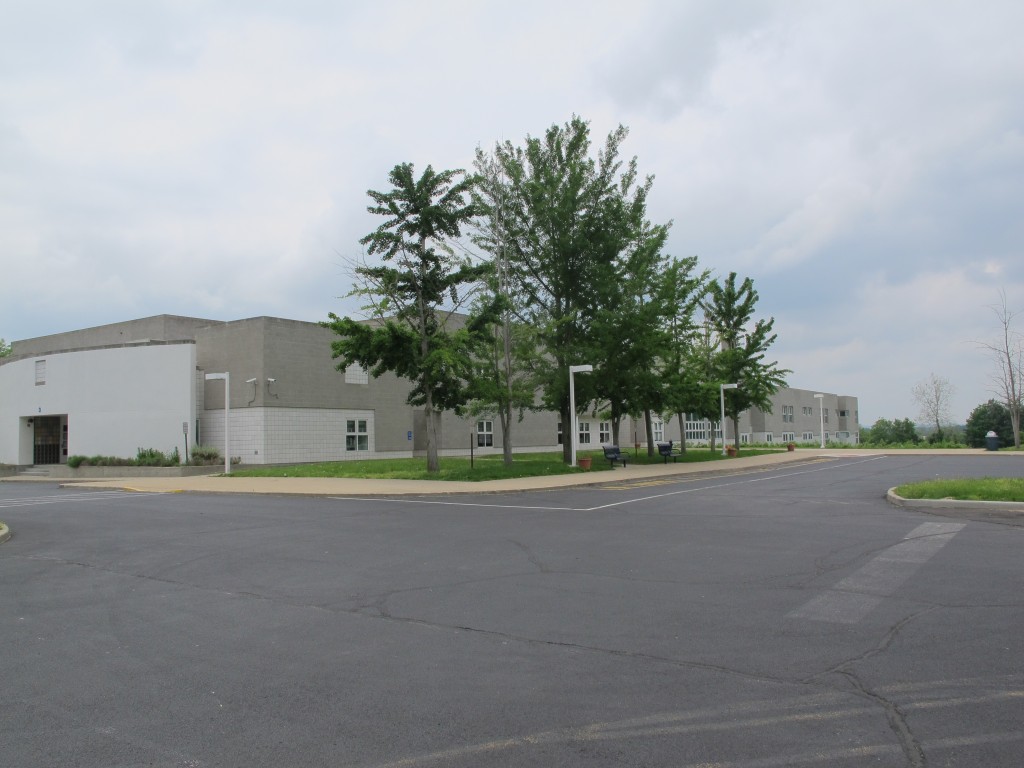 Clifty Creek Elementary (photo by Ricky Berkey)
Clifty Creek Elementary (photo by Ricky Berkey)
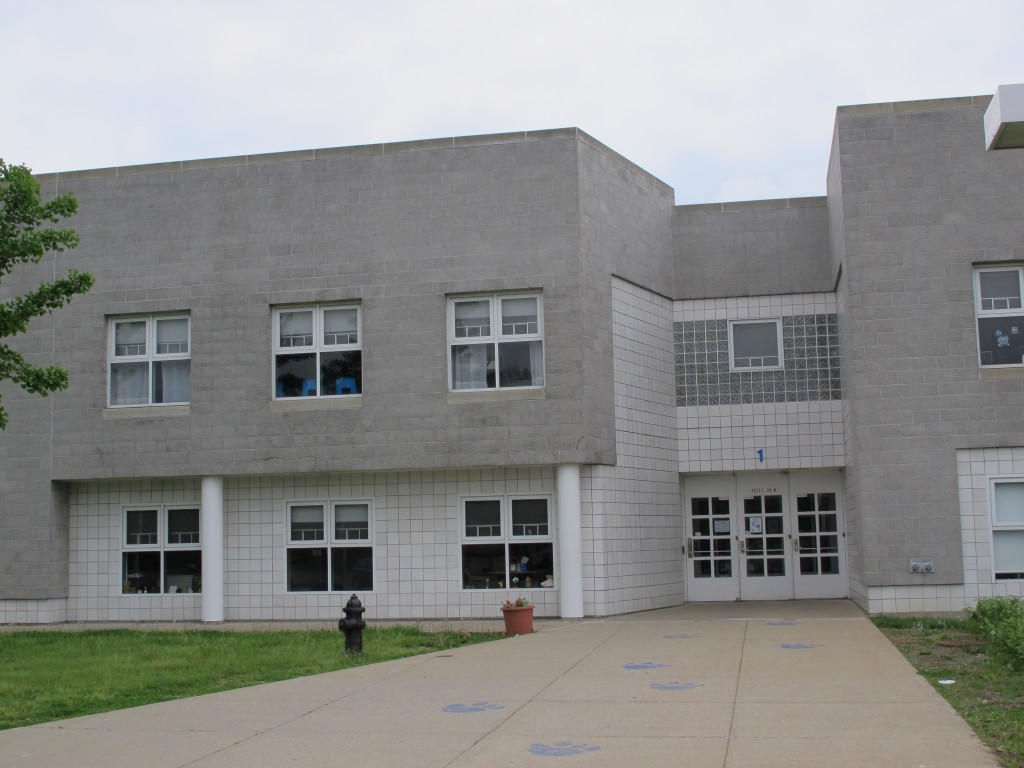 Main entryway (photo by Ricky Berkey)
Main entryway (photo by Ricky Berkey)
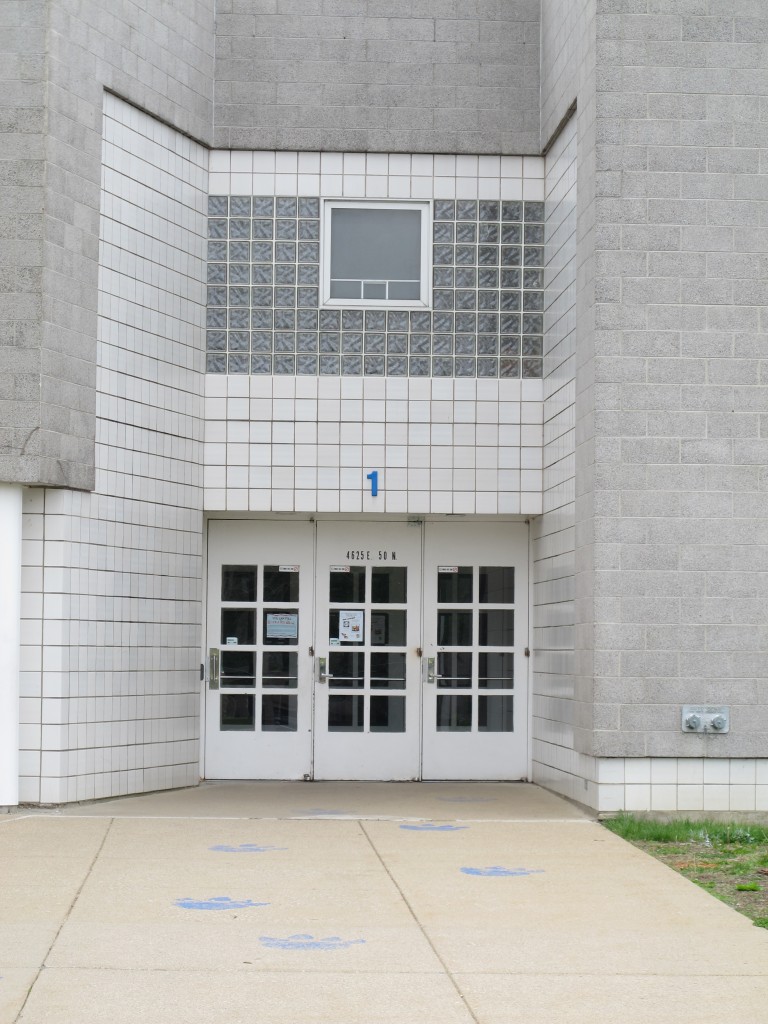 Main entryway (photo by Ricky Berkey)
Main entryway (photo by Ricky Berkey)
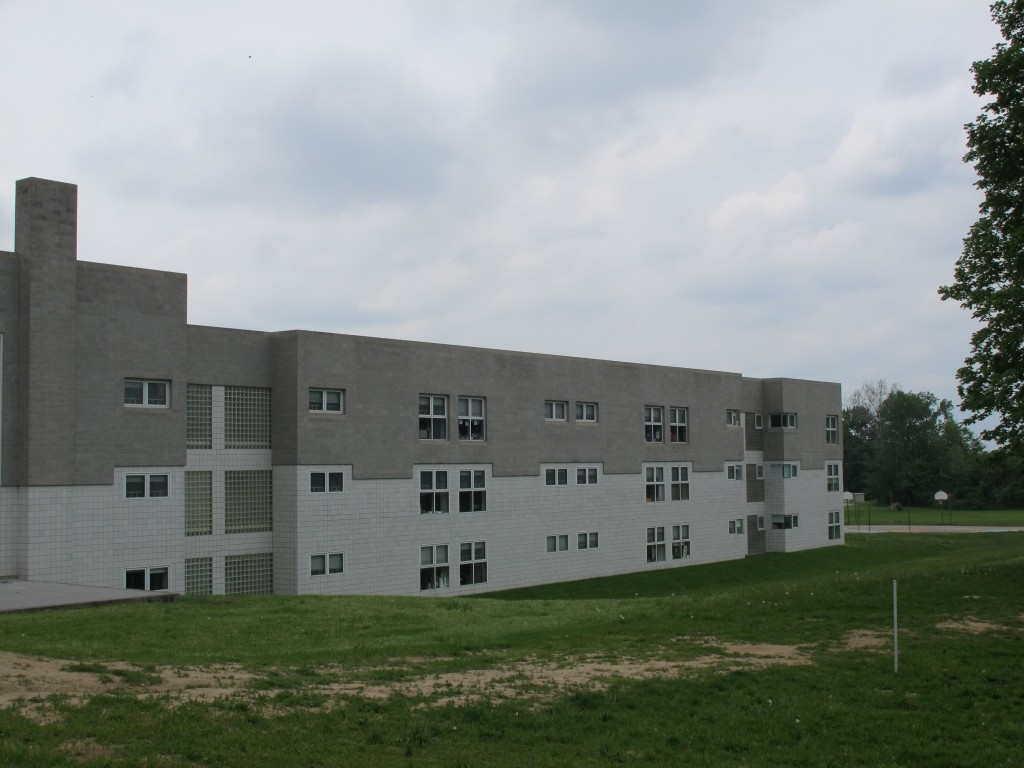 Classroom wing (photo by Ricky Berkey)
Classroom wing (photo by Ricky Berkey)
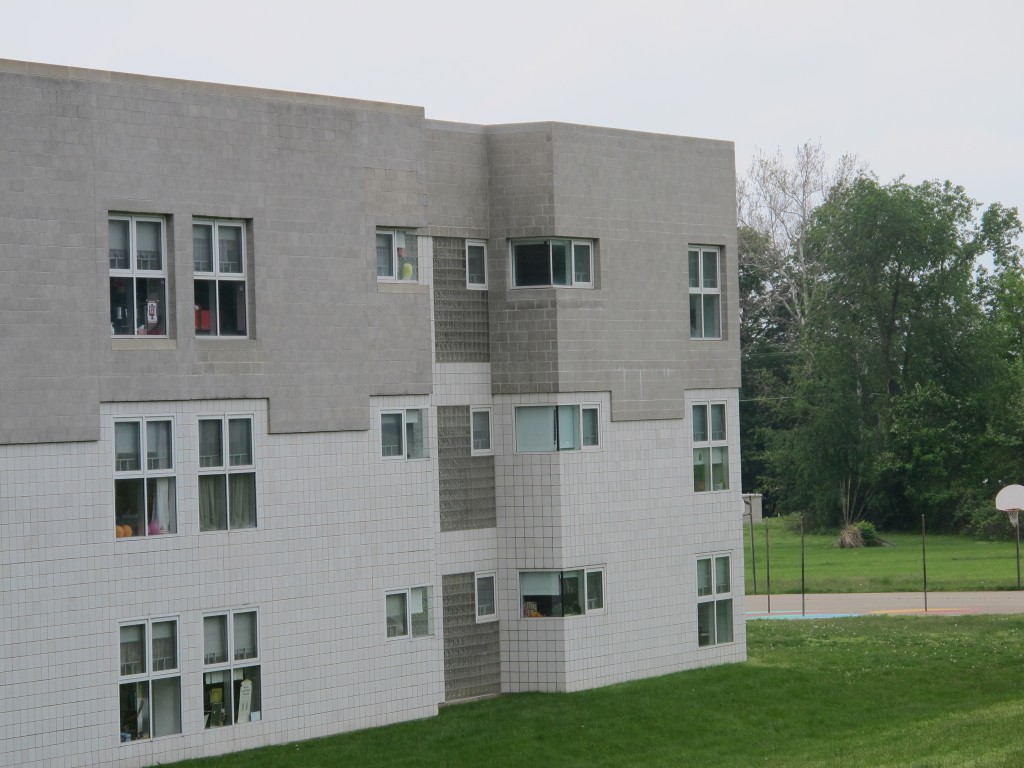 Closer view of classroom wing (photo by Ricky Berkey)
Closer view of classroom wing (photo by Ricky Berkey)
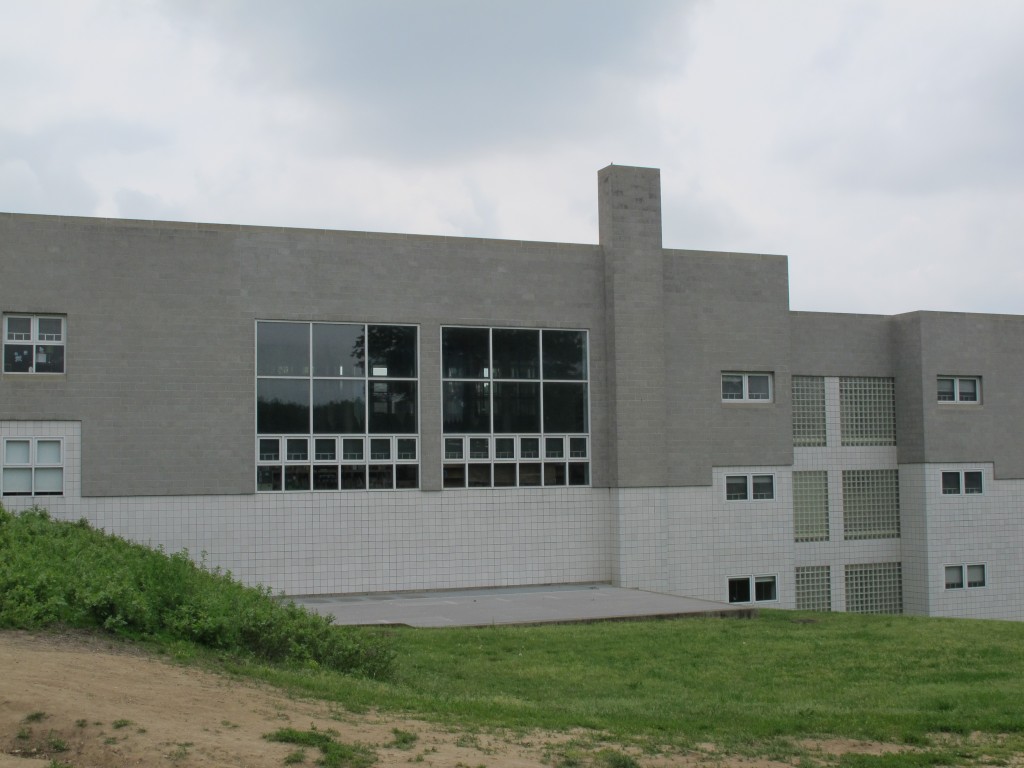 Clifty Creek Elementary (photo by Ricky Berkey)
Clifty Creek Elementary (photo by Ricky Berkey)
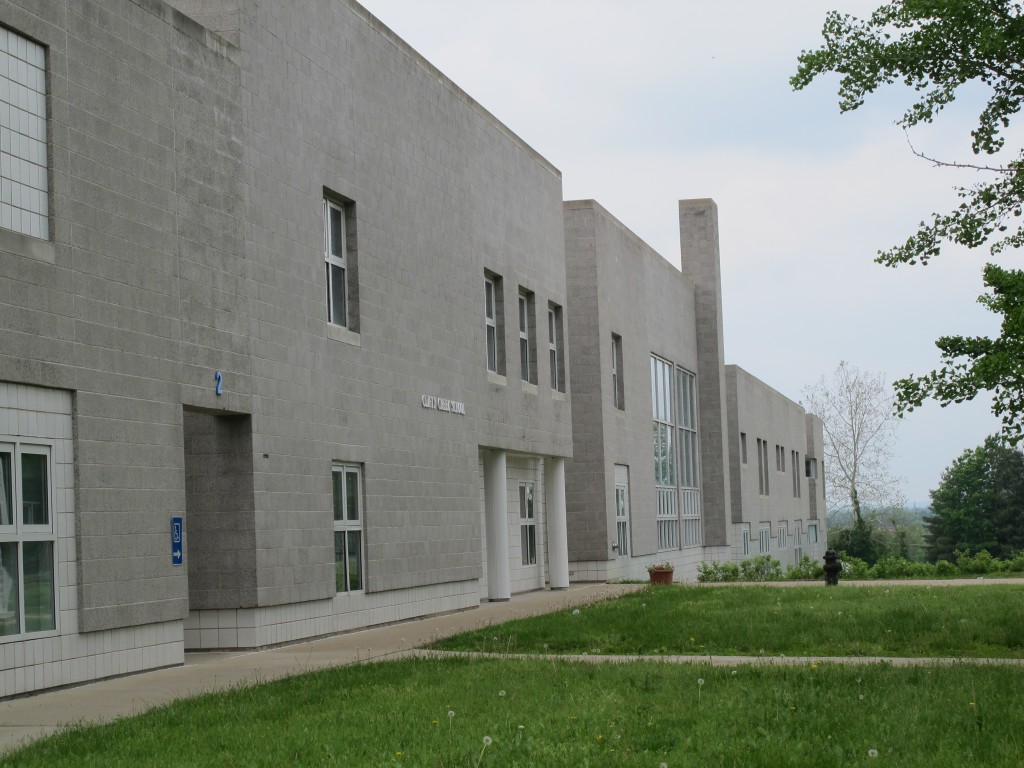 Clifty Creek Elementary (photo by Ricky Berkey)
Clifty Creek Elementary (photo by Ricky Berkey)
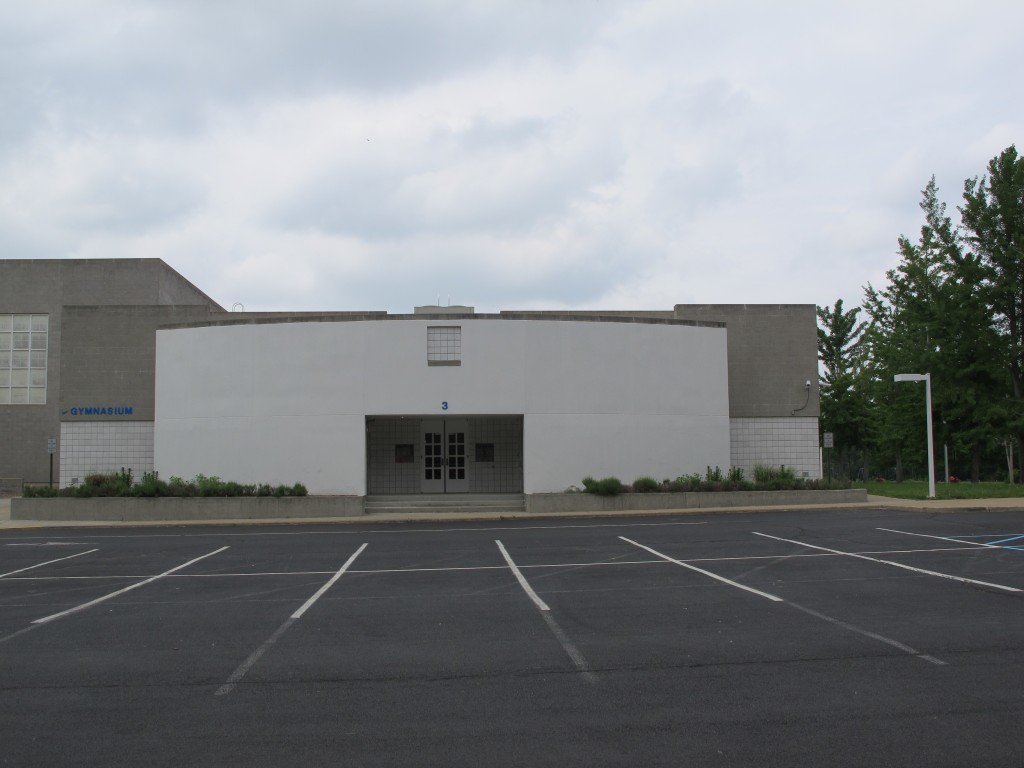 Building at the highest part of the site elevation (photo by Ricky Berkey)
Building at the highest part of the site elevation (photo by Ricky Berkey)
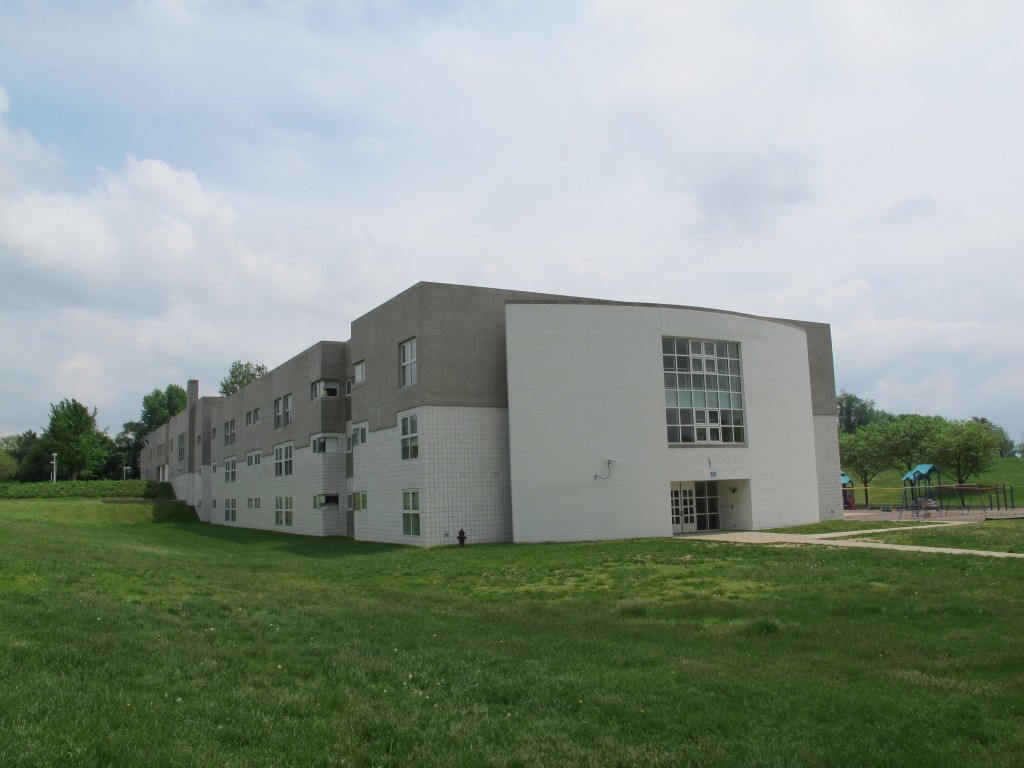 Lower level classroom wing, note the uphill elevation (photo by Ricky Berkey)
Lower level classroom wing, note the uphill elevation (photo by Ricky Berkey)
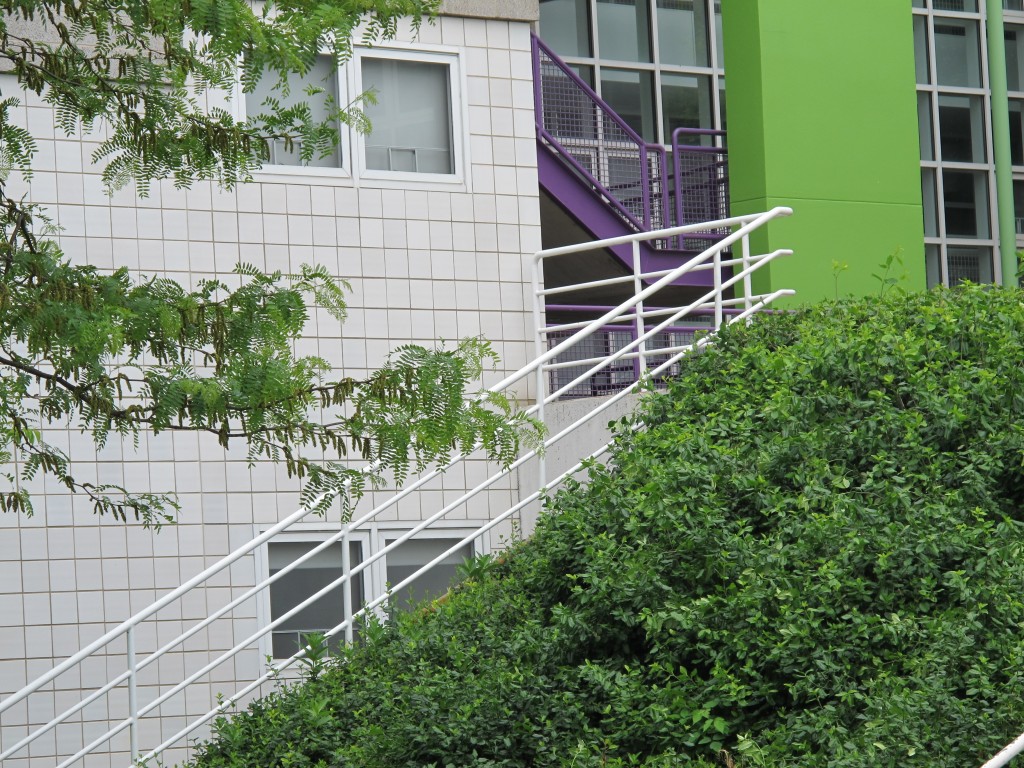 Could there be a Meier building without white external rails? (photo by Ricky Berkey)
Could there be a Meier building without white external rails? (photo by Ricky Berkey)
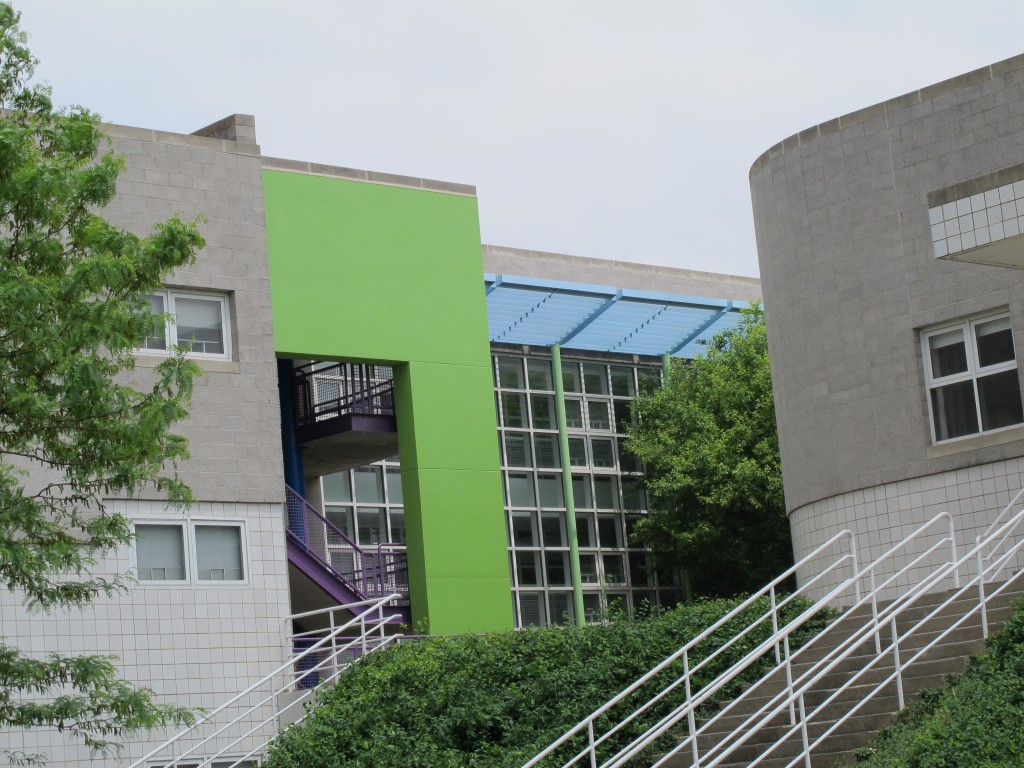 Meier fans shocked and awed by color! (photo by Ricky Berkey)
Meier fans shocked and awed by color! (photo by Ricky Berkey)
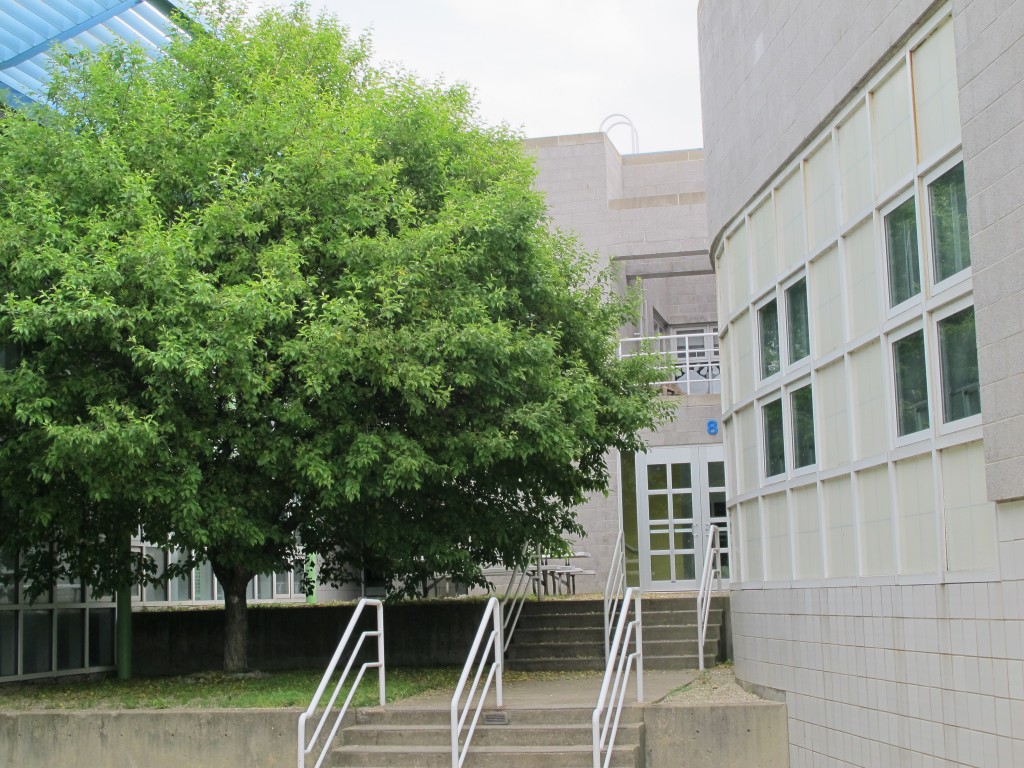 Courtyard area (photo by Ricky Berkey)
Courtyard area (photo by Ricky Berkey)
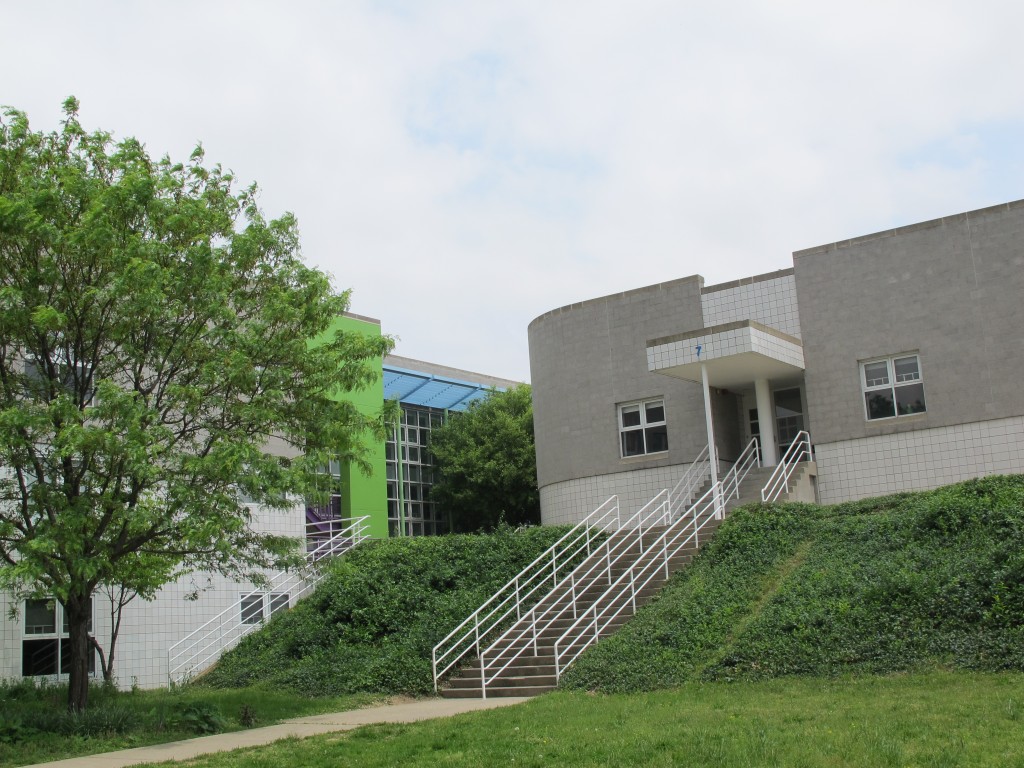 Clifty Creek Elementary (photo by Ricky Berkey)
Clifty Creek Elementary (photo by Ricky Berkey)
The Architects
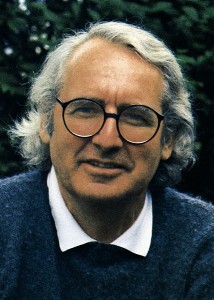 Richard Meier
Richard Meier
- Born in Newark, New Jersey on October 12, 1934
- Cornell University (1957)
- Pritzker Prize winner (1984)
- AIA Gold Medal (1997)
- Architects Gold Medal: American Academy of Arts and Letters (2008)
Meier was born in Newark, New Jersey in 1934. After earning his architecture degree at Cornell University, he presented himself to the famed architect Le Corbusier offering to work as a unpaid intern but was turned down. He worked briefly for Skidmore, Owings and Merrill in 1959 and then spent 3 years working with Marcel Breuer before starting his own practice in New York in 1963. He has completed major commissions such as corporate headquarters, museums and government buildings as well as private residences and housing.
Richard Meier has been able to remain independent throughout his career, disregarding popular trends in architecture and expressing his own design philosophy. He has been often criticized as well for never straying far from his signature style based on the International Style of the 20’s and 30’s and seldom wavering from his predilection for white buildings.
He became known in 1972 as one of the “New York Five” (along with Peter Eisenman, Michael Graves, Charles Gwathmey and John Hejduk), a group of architects who were considered purists to the International Style sticking to the tenets of modernism as most architects were moving on to other things, usually a mixture of historical styles that came to be known as post-modernism. Meier in particular was influenced heavily by the style of Le Corbusier, especially his earlier work. The “New York 5” published a book in 1972, “Five Architects” giving their opinions on the current and future state of architecture. Another group of post-modernist architects inspired by Robert Venturi responded with a critical collection of essays, “Five on Five”. The architectural press dubbed Meier and his group as the “Whites” and Venturi and his followers as the “Grays” amused by their fierce arguments about the future of architecture.
Richard Meier won the Pritzker Prize in 1984, architectures highest award. The Pritzker Prize annually honors a living architect for his entire body of work. In 1997, Meier recieved the AIA (American Institute of Architects) Gold Medal award and he has won many awards from the regional chapters of the AIA. Among the many other honors and awards he has won was the Architects Gold Medal in 2008 from the American Academy of Arts and Letters.
Among his many projects was the Getty Center in Los Angeles which took over 15 years to go from design to construction phase, finally completed in 1997. Another very interesting work in Indiana is the Atheneum in New Harmony, Indiana.
Selected Richard Meier Projects
1965: Meier House – Essex Fells, New Jersey
1967: Smith House – Darien, Connecticut
1973: Douglas House – Harbor Springs, Michigan
1976: Bronx Developmental Center – The Bronx, New York
1979: The Atheneum – New Harmony, Indiana
1982: Clifty Creek Elementary School – Columbus, Indiana
1983: High Museum of Art – Atlanta, Georgia
1984: Modern Art Wing (Des Moines Art Center) – Des Moines, Iowa
1995: Barcelona Museum of Contemporary Art – Barcelona, Spain
1996: Rachofsky House – Dallas, Texas
1996: Museum of Television and Radio – Beverly Hills, California
1997: Getty Center – Los Angeles, California
2003 -Crystal Cathedral Welcome Center – Anaheim, California
2007: City Tower – Prague, Czech Republic
2007: San Jose City Hall – San Jose, California
2007: Connoly Hall at the University of Scranton – Scranton, New York
2008: Weill Hall – Ithaca, New York
2008: Meier Tower – Tel Aviv, Israel
 Stamberg Aferiat Architecture
Stamberg Aferiat Architecture
Peter Stamberg attended Columbia College, Rhode Island School of Design and the London School of Architecture. He began his career in the office of Davis Brody and Associates.
Paul Aferiat attended Carnegie Mellon University. He began his career working in the offices of Hardy Holzman Pfeiffer and Giorgio Cavalieri and later worked with Richard Meier and Partners as well as Gwathmey Siegel and Associates.
Stamberg and Aferiat began collaborating in 1976 and founded their own firm, Stamberg Aferiat Architecture in 1989.
Links/References
Richard Meier Official Website
“Five Architects” – a controversial book from 1972 by 5 prominent architects (Richard Meier, Peter Eisenman, Michael Graves, Charles Gwathmeyand John Hejduk) on the state of architecture.
“Richard Meier and Partners, Complete Works: 1963-2008”
City of Columbus: official City of Columbus website
Columbus Indiana Architectural Archives
Columbus Indiana Architecture Digital Archives: A small portion of the Columbus Indiana Architectural Archives available online from the IUPUI digital library
3D Models of Columbus Architecture Executed in Google SketchUp:
The Republic Newspaper – Columbus, Indiana newspaper
Bartholomew County Public Library
Historic Columbus Website – David Sechrest’s tribute to Columbus History
Historic Columbus Message Board – a companion interactive forum to the David Sechrest historical website
Bartholomew County Historical Society
 Click HERE for a Calendar of Upcoming Events in the Columbus Area.
Click HERE for a Calendar of Upcoming Events in the Columbus Area.
Click HERE for information about Tours of Columbus Architecture and Design including the Miller House.
 Ricky Berkey
Ricky Berkey
Email me: rickyberkey@gmail.com
